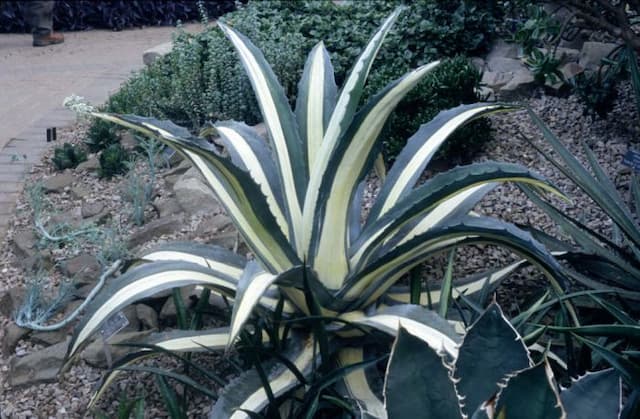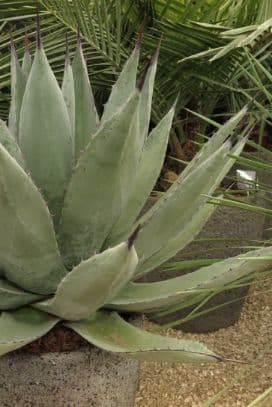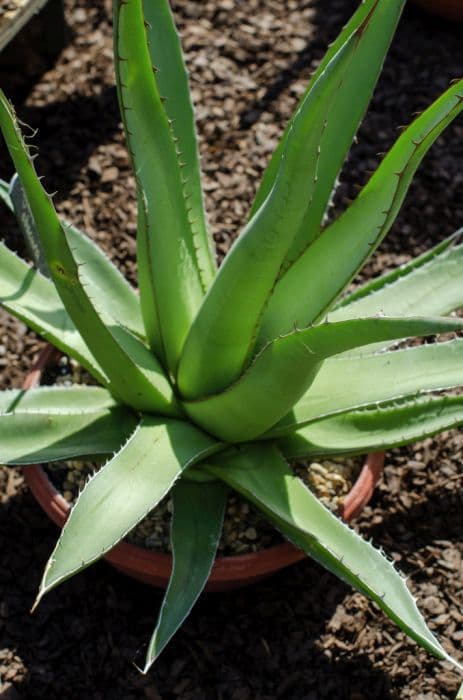Hosta Hosta 'Firn Line' (v)

ABOUT
Hosta 'Firn Line' is an ornamental plant known for its lush foliage that adds a pop of interest to shade gardens. This variety displays striking leaves that have a unique color and pattern. The leaves are broad and heart-shaped, presenting a strong and bold texture. What sets 'Firn Line' apart is the distinct variegation of its foliage; each leaf showcases a beautiful contrast between a deep green center and a crisp white, or sometimes creamy yellow, margin that appears to outline the leaf like an artist's brush stroke. The demarcation between the two colors is crisp, creating a visual effect that is quite dramatic. During its blooming period, 'Firn Line' produces delicate flowers that rise above the foliage on long, arching stalks. These blossoms can add a subtle charm to the plant's appearance. The thick leaves of the plant have a somewhat corrugated texture that adds to its lush appearance, making it an excellent ground cover that can light up the shadier parts of a garden with its variegated leaves.
About this plant
 Names
NamesFamily
Asparagaceae
Synonyms
Plantain Lily, Funkia
Common names
Hosta 'Firn Line'
 Toxicity
ToxicityTo humans
Hosta, commonly known as plantain lily, is not considered toxic to humans. They are occasionally even eaten in some cultures. However, as with any plant material, individual sensitivities can occur, and it is advisable to avoid ingesting any plant not specifically grown for consumption to prevent any potential stomach discomfort or allergic reactions.
To pets
Hosta, commonly known as plantain lily, is toxic to pets, including dogs and cats. Ingesting this plant can lead to vomiting, diarrhea, and depression in pets. If a pet ingests a significant amount of Hosta, it is important to contact a veterinarian as symptoms can be more severe and may require medical attention.
 Characteristics
CharacteristicsLife cycle
Perennials
Foliage type
Deciduous
Color of leaves
Variegated
Flower color
Lavender
Height
1-2 feet (30-60 cm)
Spread
2-3 feet (60-90 cm)
Plant type
Herbaceous
Hardiness zones
3
Native area
Asia
Benefits
 General Benefits
General Benefits- Easy to Care for: The Hosta 'Firn Line' is a low-maintenance plant, which is great for both novice and experienced gardeners.
- Shade Tolerant: This variety thrives in shady areas, making it an ideal choice for gardens with limited direct sunlight.
- Attractive Foliage: With its variegated leaves, it provides visual interest and enhances the aesthetic appeal of garden spaces.
- Drought Resistant: Once established, it can tolerate periods of dry conditions, reducing the need for frequent watering.
- Cold Hardy: Hosta 'Firn Line' is resistant to cold and can survive in lower temperatures, making it suitable for various climates.
- Pest Resistant: It has a level of resistance to common garden pests, decreasing the need for chemical treatments.
- Long-Lived: Hostas are known for their longevity and can thrive for many years with proper care.
- Ground Cover: Its dense foliage can act as ground cover, suppressing weeds and minimizing soil erosion.
- Versatile: This plant can be used in a variety of garden designs, including borders, woodland gardens, and container gardening.
 Medical Properties
Medical PropertiesThis plant is not used for medical purposes.
 Air-purifying Qualities
Air-purifying QualitiesThis plant is not specifically known for air purifying qualities.
 Other Uses
Other Uses- Accenting Water Features: Hostas, when planted near ponds or waterfalls, can help to create a lush, green backdrop that accentuates the tranquility of water features.
- Floral Arrangements: The leaves of hostas can be used in floral arrangements for their striking foliage, offering a unique texture and greenery to bouquets.
- Shade Gardens: Hostas are excellent for creating depth and interest in shade gardens, where other colorful blooms may not thrive as well.
- Container Gardening: Due to their compact size and attractive foliage, hostas like 'Firn Line' can be utilized in container gardens, either alone or with other shade-loving plants.
- Erosion Control: The dense root system of hostas can help to prevent soil erosion on slopes or in areas where ground cover is needed.
- Bonsai: With careful trimming and cultivation, some hosta varieties can be grown as bonsai, bringing an unusual twist to this traditional Japanese art form.
- Edging Plants: Hostas can be planted in a row to define garden paths and borders, providing a neat, organized appearance to the landscape.
- Garden Art: Large hosta leaves can be used as molds for garden stepping stones or concrete garden art, capturing their intricate vein patterns.
- Photography Subject: Due to their lush foliage and varied textures, hostas are often used by garden photographers as subjects to capture the essence of shade gardens.
- Wildlife Habitat: Hostas can provide shelter and food for small wildlife, such as frogs and beneficial insects, helping to support local ecosystems.
Interesting Facts
 Feng Shui
Feng ShuiThe Hosta is not used in Feng Shui practice.
 Plant Symbolism
Plant Symbolism- Resilience: Hostas, also known as plantain lilies, are known for their ability to thrive in shade and return year after year, symbolizing endurance and the ability to overcome adversity.
- Devotion: With their lush foliage that grows and expands over time, hostas can represent dedication and the nurturing of relationships.
- Healing: In some traditions, hostas are believed to have medicinal properties, hence they can be associated with healing and soothing of ailments.
- Friendship: The ease with which hostas grow and their non-invasive nature can symbolize the growth of friendship and mutual respect.
- Heartiness: Due to their robust nature and ability to grow under a variety of conditions, hostas embody robustness and adaptive vitality.
 Water
WaterHostas should be watered deeply and thoroughly, ensuring that the soil is evenly moist but not soggy. During the growing season, this is typically about an inch of water per week, either from rainfall or supplemental watering. If using a watering can or hose, this translates to approximately 0.6 gallons per square yard per week. In periods of drought or extreme heat, increase the frequency to maintain soil moisture, but always allow the top inch of soil to dry out before watering again. Reducing water in late summer can help the plant prepare for dormancy.
 Light
LightHostas, including Hosta 'Firn Line', prefer dappled or part shade. The best spot for these plants would be an area that receives morning sunlight and afternoon shade, which helps protect the leaves from scorching. Avoid exposing them to direct, harsh sunlight, especially during the hot midday hours, as this can damage the foliage.
 Temperature
TemperatureHostas thrive best in temperatures ranging from around 50°F to 75°F. Hostas 'Firn Line' can tolerate cold weather and can survive winter temperatures down to -30°F. During hot summer days, it's crucial to keep them shaded if the temperature exceeds 90°F to prevent heat stress.
 Pruning
PruningPruning for Hostas like 'Firn Line' primarily involves removing any dead or damaged leaves to maintain appearance and health. This is best done in early spring or as needed throughout the growing season. Hostas also benefit from cutting back their foliage in late fall after the first frost to help prevent disease and pests from overwintering in the dead leaves.
 Cleaning
CleaningAs needed
 Soil
SoilHostas prefer well-draining soil rich in organic matter with a pH range of 6.0 to 7.5. A mix of one part garden soil, one part peat moss, and one part perlite or coarse sand is ideal for ensuring proper drainage and fertility.
 Repotting
RepottingHostas, such as the Hosta 'Firn Line', typically need repotting every 3 to 5 years, or when the plant outgrows its container and the roots are visibly crowded.
 Humidity & Misting
Humidity & MistingHostas like the Hosta 'Firn Line' prefer moderate humidity levels but are quite adaptable to different humidity conditions outdoors. They do not require specific humidity adjustments when grown outside.
 Suitable locations
Suitable locationsIndoor
Place in bright, indirect light and keep soil moist.
Outdoor
Plant in dappled shade, keep soil consistently moist.
Hardiness zone
3-9 USDA
 Life cycle
Life cycleHosta 'Firn Line', commonly known as Funkia or Plantain Lily, begins its life as a dormant rhizome or a seed which germinates, given adequate moisture and temperature conditions. In spring, it starts its vegetative phase, producing shoots that unfurl into broad, variegated leaves with distinctive blue-green hues and creamy-white edges. Throughout the summer, it reaches maturity and blooms, sending up tall scapes crowned with lavender or white bell-shaped flowers that attract pollinators. After flowering, seed pods may develop, though many gardeners remove the flower stalks to promote foliage growth. As autumn approaches, the leaves start to die back, with the plant preparing to enter a period of dormancy as temperatures drop. Over winter, the plant rests below ground, with its rhizome storing energy for the next growing season's growth and the cycle repeats.
 Propogation
PropogationPropogation time
Early Spring
The most popular method of propagating Hostas, including the Hosta 'Firn Line', is through division. This process is ideally carried out in the early spring as the new shoots, commonly referred to as "pips", begin to emerge from the ground. At this time, the plant can be dug up carefully to minimize root damage. The clump should be divided into smaller sections, with each section containing at least two or three shoots and a portion of the root system. These separated sections can then be immediately replanted into prepared soil, ensuring that they are placed at the same soil depth as they were originally growing. By keeping the divisions well-watered, they should establish themselves quickly and begin to grow as separate plants, effectively multiplying the Hosta collection.









